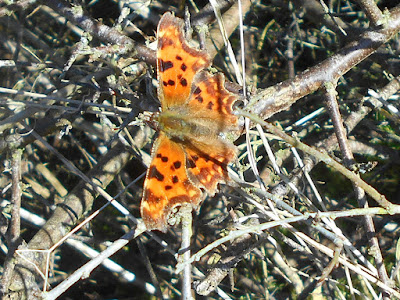Nevertheless, the weather was glorious, although my friend Lynda apparently rose this morning to find a light frost. Yesterday Chris and I celebrated our wedding anniversary and we received a fine Camellia from Jacqui and Dean. I have potted it up and there should be some lovely flowers soon, so a frost would not be welcome. Luckily our back garden is fairly sheltered.
 |
Our Camellia is close to flowering and a frost would not be welcome.
25 February, 2019
|
Anyway, where was I?
Yes, the weather was lovely at Foxhill Farm and a Comma, Polygonia c-album, was flitting back and forth along the track where I was busy recording. The main food plant of this butterfly is Stinging Nettle, so no problem there. I find that it is often one of the first butterflies to be seen in the spring.
 |
| A comma was on the wing at Foxhill Farm. 25 February, 2019 |
I was pleased to record the jumping spider Euophrys frontalis, not because it is rare (it is one of our commonest spiders in grassland and light woodland) but because there is something about jumping spiders which brings a smile to the face. Silly though it sounds they are, to me and many others, oddly endearing, difficult to explain but probably related to their large forward-facing eyes. It gives them a strangely intelligent appearance. The species best-known to the public is probably the zebra spider, Salticus scenicus, common on warm walls and wooden fencing. Obviously they are able to jump, creeping up to and leaping upon their prey. Some jumping spiders are able to leap twenty times their own body length.
Euophrys frontalis, despite being so common, was a first record for the farm. Also a first record was the caterpillar of a Brown-line Bright-eye, Mythimna conigera, a very common moth. How I'd failed to record it last year is anyone's guess. Lepidopterists don't make it easy for the recorder because there is also a moth called the Bright-line Brown-eye, Lacanobia oleracea, the caterpillar of which can occasionally be a pest of tomatoes.
Euophrys frontalis, despite being so common, was a first record for the farm. Also a first record was the caterpillar of a Brown-line Bright-eye, Mythimna conigera, a very common moth. How I'd failed to record it last year is anyone's guess. Lepidopterists don't make it easy for the recorder because there is also a moth called the Bright-line Brown-eye, Lacanobia oleracea, the caterpillar of which can occasionally be a pest of tomatoes.
 |
A not-very-well-focused photograph - sorry. Brown-line Bright-eye larva
at Foxhill Farm, 25 February, 2019
|
No comments:
Post a Comment